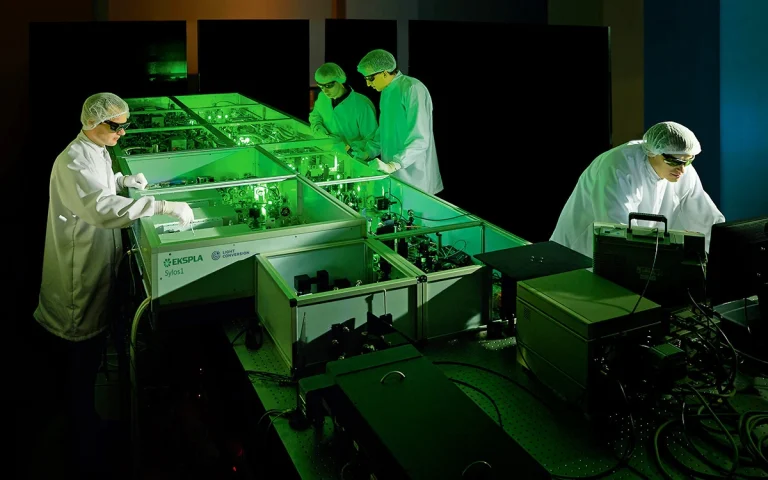为 ELI-ALPS 构建一台 15 TW 激光器
On 25 November, the ELI-ALPS (Extreme Light Infrastructure Attosecond Light Pulse Source) facility and consortium between EKSPLA and LIGHT CONVERSION, following continuing collaboration between the three parties, signed a research and development contract for building a new laser system, called SYLOS 3, for ELI-ALPS.
The new system, estimated at ~6 m. Euros will deliver unique parameters, never before achieved in a commercially available system. more than 15 TW peak power at 1 KHz repetition rate and less than 8 femtoseconds pulse duration. Compared to the SYLOS2A system (4.5 TW, 6,3 fs, 1 kHz), already installed at ELI-ALPS, the new system will provide more than 3 times higher peak and average power.
„The ELI-ALPS SYLOS 3 laser system is planned to generate coherent X-ray radiation through gas and surface higher-order harmonic generation, as well as electron acceleration in order to serve various experiments, “ mentioned Adam Börzsönyi, Head of Laser Sources Division at ELI-ALPS. „One of the many applications is the generation of isolated attosecond pulses for attosecond metrology. The beamlines operated with the SYLOS laser are designed for user operation and demand high stability of operation with high up-time. These tasks will be the top priority when designing and developing the SYLOS 3 system.“
Due to the exceptionally large XUV/X-ray energy, this system opens up the route to nonlinear XUV and X-ray science as well as 4D imaging and industrial, biological, and medical applications.
The main objective of the ELI-ALPS (Extreme Light Infrastructure Attosecond Light Pulse Source) project is to create a unique European research center, providing the international research community with exceptional laser pulses and secondary sources. The Szeged facility will stand out from the institutes producing the highest intensity laser pulses in the world at a 1 kHz pulse repetition rate.
“Unlike other TW level systems available in the market, which are operating at single-shot or low frequency regimes, SYLOS 3 will be running at 1 KHz repetition rate,” mentioned Kestutis Jasiūnas, EKSPLA CEO. „This innovative approach will enable researchers to collect much more data and take experiments to the next level. Armed with such tools, researchers will also be able to step from fundamental into the applied science experiments area and develop promising future technologies like a laser-based particle accelerator“.
The SYLOS3 laser system will be based on OPCPA (Optical Parametric Chirped-Pulse Amplification) technology. Developed at Vilnius University, today OPCPA is the leading method for generating high-intensity radiation as it prevails compared to conventional (Ti:Sapphire laser-based) femtosecond technology in terms of pumping efficiency, contrast, bandwidth, and, as a consequence, the degree of control of the generated radiation.
“Despite being complex, the system will ensure exceptional stability,” – added Martynas Barkauskas, LIGHT CONVERSION CEO, “SYLOS 3 will deliver ~120 mJ pulses with ≤ 250 mrad CEP stability and energy stability ≤ 1%.”
A three times peak power increase compared with the previously built system means more than three times the complexity increase. Engineers will be facing many challenges; thermal dissipation, water/electrical consumption, personal safety systems, space and weight restrictions, and multiple channel combinations are only a few of these.
Even if the backbone of the system will be a reliable industry-tested technology, to ensure reliability, it will be designed and built from scratch. All manufacturing will be carried out in Vilnius, Lithuania. Delivery and installation are planned at the end of 2022.
